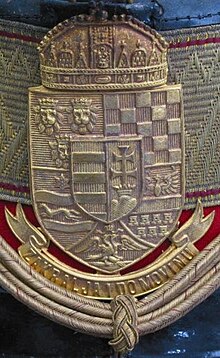
Svetozar Boroević von Bojna was an Austro-Hungarian field marshal who was described as one of the finest defensive strategists of the First World War. He commanded Austro-Hungarian forces in the Isonzo front, for which he was nicknamed the "Lion of Isonzo".
Landwehr, or Landeswehr, is a German language term used in referring to certain national armies, or militias found in nineteenth- and early twentieth-century Europe. In different context it refers to large-scale, low-strength fortifications. In German, the word means "defence of the country"; but the term as applied to an insurrectional militia is very ancient, and lantveri are mentioned in Baluzii Capitularia, as quoted in Henry Hallam's Middle Ages, i. 262, 10th edition.

The Austro-Hungarian Army, also known as the Imperial and Royal Army, was the principal ground force of Austria-Hungary from 1867 to 1918. It consisted of three organisations: the Common Army, the Imperial-Royal Landwehr and the Royal Hungarian Honvéd.
The military history of Croatia encompasses wars, battles and all military actions fought on the territory of modern Croatia and the military history of the Croat people regardless of political geography.

The Croatian Home Guard was the land army part of the armed forces of the Independent State of Croatia which existed during World War II.
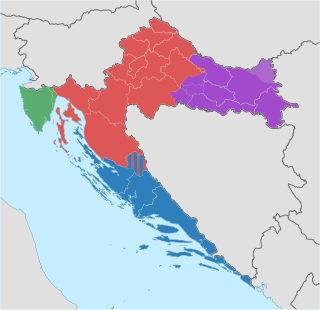
Though the Republic of Croatia administratively consists of twenty counties, it is traditionally divided into four historical and cultural regions: Croatia proper, Dalmatia, Istria, and Slavonia. These are further divided into other, smaller regions.
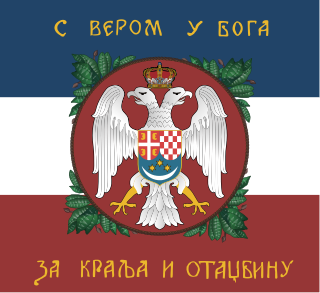
The Yugoslav Army, commonly the Royal Yugoslav Army, was the land warfare military service branch of the Kingdom of Yugoslavia. It existed from the Kingdom's formation in December 1918, until its surrender to the Axis powers on 17 April 1941. Aside from fighting along the Austrian border in 1919 and 1920 related to territorial disputes, and some border skirmishes on its southern borders in the 1920s, the JV was not involved in fighting until April 1941 when it was quickly overcome by the German-led invasion of Yugoslavia.

The 42nd Home Guard Infantry Division, nicknamed the Devil's Division was an infantry division of the Royal Croatian Home Guard within the Austro-Hungarian Army which was active in World War I.
Josip Metzger was a member of the fascist Ustaše movement who rose to the rank of major general in the Independent State of Croatia during World War II. He was tried, sentenced and executed for war crimes after the war.

Together with the Dragoons and Uhlans, the Imperial and Royal Hussars, made up the cavalry of the Austro-Hungarian Army from 1867 to 1918, both in the Common Army and in the Hungarian Landwehr, where they were known as the Royal Hungarian Hussars.
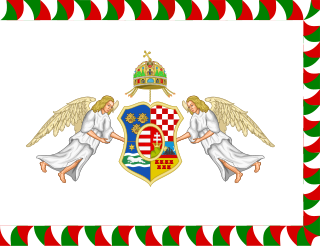
The Royal Hungarian Honvéd or Royal Hungarian Landwehr, commonly known as the Honvéd, was one of the four armed forces of Austria-Hungary from 1867 to 1918, along with the Austrian Landwehr, the Common Army and the Imperial and Royal Navy. The term honvéd was used to refer to all members of the Hungarian land forces in 1848-49, but it was also used to refer to enlisted private soldiers without a rank.

The 4th Army was a Royal Yugoslav Army formation mobilised prior to the German-led Axis invasion of the Kingdom of Yugoslavia during World War II. It was drawn from the peacetime 4th Army District. When mobilised, it consisted of three divisions, a brigade-strength detachment, one horse cavalry regiment and one independent infantry regiment. It formed part of the 1st Army Group, and was responsible for defending a large section of the Yugoslav–Hungarian border, being deployed behind the Drava river between Varaždin and Slatina. Like all Yugoslav formations at the time, the 4th Army had serious deficiencies in both mobility and firepower.
The 42nd Infantry Division Murska was an infantry formation of the Royal Yugoslav Army that formed part of the 4th Army during the German-led Axis invasion of the Kingdom of Yugoslavia in April 1941. It did not have a corresponding divisional district in peacetime, and was raised at the time of mobilisation. Like all Yugoslav infantry divisions of the time, it was a very large and unwieldy formation which was almost entirely reliant on animal transport for mobility, and also lacked modern arms and sufficient ammunition. Commanded by Divizijski đeneral Borisav Ristić, it was largely manned by Croat troops, many of whom saw the Germans as potential liberators from Serbian oppression.
The 27th Infantry Division Savska was an infantry formation of the Royal Yugoslav Army that formed part of the 4th Army during the German-led invasion of Yugoslavia by the Axis powers in April 1941. It was raised from the Savska divisional district, and like all Yugoslav infantry divisions of the time, was a very large and unwieldy formation almost entirely reliant on animal transport for mobility. Commanded by Divizijski đeneral August Marić, the division was largely made up of ethnic Croat troops, many of whom saw the Germans as potential liberators from Serbian oppression during the interwar period. It also lacked modern arms and sufficient ammunition.
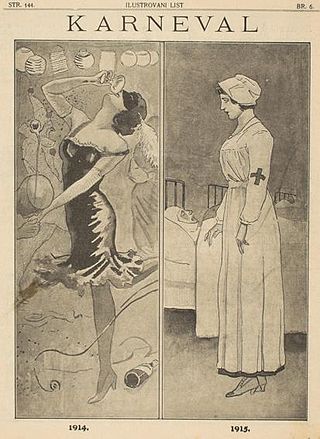
The Triune Kingdom of Croatia, Slavonia and Dalmatia was part of Austria-Hungary during World War I. Its territory was administratively divided between the Austrian and Hungarian parts of the empire; Međimurje and Baranja were in the Hungarian part (Transleithania), the Kingdom of Croatia-Slavonia was a separate entity associated with the Hungarian Kingdom, Dalmatia and Istria were in the Austrian part (Cisleithania), while the town of Rijeka had semi-autonomous status.

Johann von Salis-Seewis also known as Johann Ulrich Graf von Salis-Seewis was an Austro-Hungarian military officer during World War I. Austrian Salis-Seewis commanded the Croatian 42nd Honvéd Infantry Division first as part of the unsuccessful Serbian Campaign of 1914 and then on the Carpathian Front. On his return, he became military commander of Vienna before serving as the first military governor of the Military General Governorate of Serbia during the Austro-Hungarian occupation. He later commanded the 92nd Landwehr Infantry Division during the Romanian campaign and headed the Supreme Command in occupied Romania. After the dissolution of the Austro–Hungarian monarchy, following its defeat in the war, Salis-Seewis settled in Croatia where he got involved with the Croatian fascist Ustaše.

The Lipošćak affair was an alleged conspiracy led by the former Austro-Hungarian Army General of the Infantry Anton Lipošćak to seize power in the recently proclaimed State of Slovenes, Croats and Serbs at the end of the First World War. The majority view of the allegations is that they were fabricated by allies of the Croat-Serb Coalition leader Svetozar Pribičević. Lipošćak was arrested on 22 November 1918 under suspicion of treason. He was accused of plotting to establish councils composed of workers, peasants and soldiers in place of the existing authorities with the aim of reviving the Habsburg monarchy, or working on behalf of foreign powers or the Bolsheviks.

On 5 December 1918, the National Guards and Sokol volunteers suppressed a protest and engaged in an armed clash against the soldiers of the 25th Regiment of the Royal Croatian Home Guard and the 53rd Regiment of the former Austro-Hungarian Common Army on 5 December 1918, four days after the proclamation of the Kingdom of Serbs, Croats and Slovenes. National Guardsmen stopped the soldiers at the Ban Jelačić Square in Zagreb.

In the immediate aftermath of World War I, the region of Međimurje was occupied by forces loyal to the National Council of the State of Slovenes, Croats and Serbs, one of the predecessor states to the Kingdom of Yugoslavia, in November and December 1918. Predominantly inhabited by Croats, this territory was a part of the Kingdom of Hungary until it was captured by Yugoslav forces. The region was annexed by Yugoslavia, which was awarded it at the Paris Peace Conference (1919–1920).

Međimurje under Hungarian rule is the historical period of Međimurje, the northernmost part of Croatia, from the Early modern period to Late modern period, during which it was an integral part of Zala County in Hungary. It was a centuries-old aspiration of the Hungarian rulers that came true in 1720, as Međimurje was acquired by Michael Johann III. Althann (1679–1727), a Habsburg Count and member of the House of Althann, an ancient German noble family. Until then, although in the possession of Croatian, Hungarian and Austrian noblemen, Međimurje was mostly part of the Varaždin County, which formally belonged to the medieval Kingdom of Slavonia or early modern Kingdom of Slavonia, one of Croatian lands. From 1527 the entire territory fell under Habsburg Monarchy and after the formation of Croatian Military Frontier on parts of the Croatian territory, Međimurje remained outside it and was, as before, under the administration of the Ban (Banus) of Croatia.

